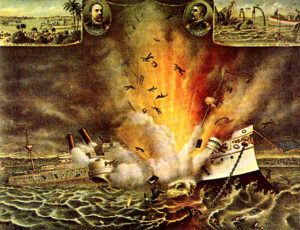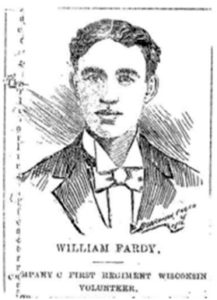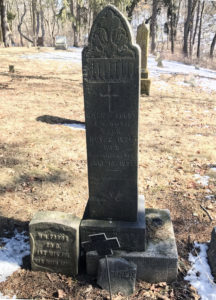
On April 28, 1898, the U.S. Congress declared war with Spain following the sinking of an American ship. Nearly two months earlier, the USS Maine, an armored cruiser naval ship, exploded in the harbor of Havana Cuba killing nearly three quarters of her crew. The ship was sent there to protect US interests during the Cuban revolt against Spain.
At twenty-two years of age, William Fardy was Eagle Wisconsin’s sole enlistee in the Spanish-American War. He joined Company C, 1st Wisconsin Infantry, along with a group of young men from Whitewater Wisconsin, on May 14, 1898, being assembled at Camp Harvey in Milwaukee under Colonel Samuel Schadel. The regiment moved to Camp Cuba Libre in Jacksonville, Florida where they trained for an assault on Havana, Cuba.
The heat, humidity, mosquitos and conditions of summer training in Florida were miserable, but the 1st Wisconsin Regiment, with over 1,225 men prepared for battle. While in training, an armistice ended the fighting on August 12, 1898 and the 1st Wisconsin Infantry never saw battle. Still, the 1st Wisconsin suffered 40 enlisted men who died of disease, including William Fardy, who died of typhoid fever on July 14,1898. His body was returned to Eagle Wisconsin for burial and this is the articles that appeared in the Eagle Quill newspaper on July 22, 1898.
WILLIAM  FARDY
FARDY
Nov 2, 1876 / July 14, 1898
COMPANY C FIRST REGIMENT
WISCONSIN VOLUNTEERS
The announcement of the death of William Fardy at Jacksonville, Florida, last Thursday whose obituary appeared in our last issue cast a cloud of sorrow over the entire village and out of respect for the deceased all our flags were placed at half mast. The remains arrived here unaccompanied, on Monday on the 4:12 pm train in a metallic casket hermetically sealed. Positive intelligence of the coming of the remains reached here at 3 o’clock and being general know brought a large gathering at the railroad station of friends who were anxious to see the casket containing the body of the soldier boy who was the first from Eagle to sign the roll of volunteers and go forth to follow his country’s flag in a war for humanity with a foreign foe. On arrival of the train the casket was covered with the national colors and promptly taken to the baggage room where the undertaker took charge. After the necessary examination of the accompanying death certificate and finding all satisfactory the casket was thence removed to the chapel of St. Theresa’s church by the active pall bearers under the escort of the honorary pall bearers where the remains lay in state overnight guarded by a large number of friends and also a delegation of the G.A.R. post. At 8 a.m. the following morning the remains were removed to the church room where the funeral services were held.
The large church room was appropriately decorated with a blending of national colors, flags and black from altar to rear balcony. From the dome to the lower corners were strips of the red, white and blue intertwined with black. The front palling approaching the main altar was beautifully draped. On the left hand side was the large flag that floats on the flag staff on the church ground in front of the parsonage over which was a strip of mourning held together with silver cords. On the railing on the right of the main entrance was a marble cross and silver star profusely decorated with flowers representing the national emblem. The main altar was also dressed in mourning and together with the main church room gave the edifice a very artistic appearance for the sad occasion. The casket rested at the head of the main aisle directly in front of the altar. The floral decorations of the casket consisted of wreaths and bouquets of flowers trimmed with national colors. A touching tribute of the surviving comrades in the shape of a pillow of flowers and ferns bearing the inscription “Our Comrade.” On the foot of the casket was a silvery cross emblematical of the Catholic Faith together with a plate representing a sheaf of wheat.
 The tolling of the church bell at 9 o’clock announced the beginnings of the funeral ceremonies. And at this time the church was filled to its utmost capacity. The active and honorary pall bearers were seated directly in front and to the left of the casket. Solemn high mass was celebrated with Rev. J.J. Weinhoff, of East Troy, as celebrant, Rev. Ryan as deacon of mass and Rev. A.J. Nickel, resident pastor, as master of ceremonies. At the conclusion of the services at the church Rev. J.J Reilly, of Whitewater, who is closely identified with the interests and welfare of company C of which the deceased was a member and who was personally acquainted with nearly all of the company, delivered the funeral oration which was full of ardent patriotism and consolation. At the conclusion of his oration the remains were conveyed to St. Theresa’s cemetery for interment. The funeral cortege formed on the main entrance of the church and were headed by the color bearer and honorary pall bearers of the local G.A.R post with arms proceeded through the public square to his last resting place. The procession was a large and sympathetic one and evidenced the extent of the sympathy to the bereaved relatives and the friendship and esteem in which he was held in his home. The universal expression to sorrow by the people of Eagle for the loss of their first soldier boy in the present war was plainly visible and was a means of consolation to his family and friends. The ceremonies at the grave were conducted by Rev. A.J. Nickel, Rev. Reilly and Rev. Schmidt and were very solemn and impressive. After the casket was lowered into the grave the honorary pall bearers formed in lines on each side of the grave and fired a parting military salute after which the sad procession departed. The funeral arrangements were perfect in detail and those in charge deserve credit for their management.
The tolling of the church bell at 9 o’clock announced the beginnings of the funeral ceremonies. And at this time the church was filled to its utmost capacity. The active and honorary pall bearers were seated directly in front and to the left of the casket. Solemn high mass was celebrated with Rev. J.J. Weinhoff, of East Troy, as celebrant, Rev. Ryan as deacon of mass and Rev. A.J. Nickel, resident pastor, as master of ceremonies. At the conclusion of the services at the church Rev. J.J Reilly, of Whitewater, who is closely identified with the interests and welfare of company C of which the deceased was a member and who was personally acquainted with nearly all of the company, delivered the funeral oration which was full of ardent patriotism and consolation. At the conclusion of his oration the remains were conveyed to St. Theresa’s cemetery for interment. The funeral cortege formed on the main entrance of the church and were headed by the color bearer and honorary pall bearers of the local G.A.R post with arms proceeded through the public square to his last resting place. The procession was a large and sympathetic one and evidenced the extent of the sympathy to the bereaved relatives and the friendship and esteem in which he was held in his home. The universal expression to sorrow by the people of Eagle for the loss of their first soldier boy in the present war was plainly visible and was a means of consolation to his family and friends. The ceremonies at the grave were conducted by Rev. A.J. Nickel, Rev. Reilly and Rev. Schmidt and were very solemn and impressive. After the casket was lowered into the grave the honorary pall bearers formed in lines on each side of the grave and fired a parting military salute after which the sad procession departed. The funeral arrangements were perfect in detail and those in charge deserve credit for their management.
Eagle Quill July 22, 1898
That wasn’t the end however! There was some controversy that riled up the residents of Eagle as reported in the Waukesha Freeman newspaper in August 1898.
WILLIAM FARDY
Source: Waukesha Freeman, August 25, 1898 | Page 4
Painful Story Proves Untrue.
The painful story circulated in the western part of the county, that the coffin supposed to contain the body of young William Fardy, the Eagle volunteer who died at Jacksonville, did not contain the body at all but was weighted with stones, has been proven untrue. Last Thursday the casket was taken from the grave in the Eagle cemetery and was opened. The friends who had known Fardy in life again gazed upon his face. The body was well preserved and was clothed in a uniform with the American flag draped across the chest. The casket also contained a letter to the undertaker, some clothes, scissors and a razor the southern undertaker having evidently expected the casket would be opened upon its arrival here.
Will. Fardy enlisted in the First Wisconsin in May and died of typhoid fever July 14 at Jacksonville. His body was sent home to his parents in Eagle. It is understood that one of his comrades in Jacksonville wrote the ghastly story home that the coffin did not contain the body.
http://www.linkstothepast.com/waukesha/obitsF.php
William Fardy Family
William Fardy’s father, Lawrence, was born in Ireland in 1850 and emigrated to America with his parents Patrick and Anastatia in 1851, settling in New York. With many Fardy relatives already living in Wisconsin, Lawrence arrived here about 1871 and married Sarah Ann Allpress in Walworth Wisconsin, on March 21, 1874. William Fardy was born on November 2, 1876 in Eagle Wisconsin, the second of eight children. His siblings included James Patrick, b. 1874, Anastasia, b. 1879, Lawrence Bert, b.1881, Matthew P, b. 1885, Rosalie, b. 1888, Johnny A, b. 1891 and Cecelia Marie, b. 1894. The family ran a farm near Paradise Springs in Eagle.
William Fardy’s mother, Sarah Allpress, was born March 19, 1855 in London England, one of eight children born to William and Sarah (Percival) Allpress. They arrived in America shortly thereafter, settling in Wisconsin in 1856. Daughter Rose was born in Eagle Wisconsing in 1859. They ran a sixty-acre farm adjacent to the Fardy family at Paradise Springs.
William Fardy, his parents Lawrence and Sarah, one year old sister Cecilia and grandparents Patrick and Anastatia are all buried at the old St Theresa cemetery on Antique Lane in Eagle Wisconsin. The Allpress family members are buried ag Oak Ridge cemetery in Eagle.
William Fardy’s story hasn’t been told for 120 years! There was no wife or children to remember him. His story, like so many who give their lives in the service of our nation, is soon forgotten after only a couple of generations. We are duty-bound to find and re-tell the life stories of our fallen heros so future generations will know the sacrifices made!
Mike Rice – Author
+++++++++++++++++++
Fardy Gravestones at St. Theresa Cemetery in Eagle Wisconsin